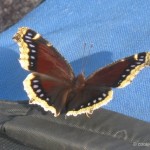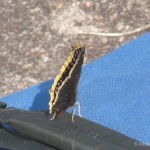Mourning Cloak Butterfly, Nymphalis antiopa
Nymphalis antiopa. Mourning Cloak.
Mourning Cloak butterflies, members of the Nymphalidae Family, are common throughout North America and into northern South America. They are also native and common to Europe and Asia. The species is known in Europe by a variety of names, including Camberwell Beauty in Great Britain, along with Grand Surprise and White Petticoat; the Trauermantel in Germany; sorgmantel in Swedish; and Sørgekåpen in Norway. One of the names of its immature, caterpillar form is spiny elm caterpillar.
The handsome butterfly pictured here, perched on top of a backpack, was photographed by my husband in 2012 in Woodlands Caribou Park, Northwestern Ontario. Boreal forest is prime territory for these large butterflies, which in the larvae stage feed upon leaves of their host plants, such as willow, elm, and popular trees, along with hackberry, hawthorns, and wild rose shrubs. Adult butterflies feed on nectar of such flowers as daisy, milkweek, and willow catkins, sap, rotting fruit, and dung. Their range is not limited to the forests, although that is preferred habitat. They can also be found in farmyards, at the edges of towns and cities, and along streams and rivers.
Spring sightings of Mourning Cloaks are often more common than other types of butterflies in Canada. The butterflies do not migrate, but instead hibernate and overwinter in the forest. Holes in the trees, piles of leaves, sheds, uneven surfaces in the tree bark, and other sheltered locations offer protection during the hibernation period. The adults mate in the spring, beginning the life cycle anew.
The Mourning Cloak is described as one of the longest living butterfly species in North America, living in its butterfly stage for 9 – 12 months.
Photos: AK Text: NK
Location: Caribou Woodlands Park, Canada
Copyright: cookiebuxton.com
Sources:
The recently published (2013) Field Guide, Manitoba Butterflies;
Canadian Biodiversity Information Facility (CBIF) http://www.cbif.gc.ca/spp_pages/butterflies/species/MourningCloak_e.php;
Wikipedia http://en.wikipedia.org/wiki/Nymphalis_antiopa
Photo Gallery
To enlarge photos and view the gallery, double click on any image, and click on the right side of the image to advance.



